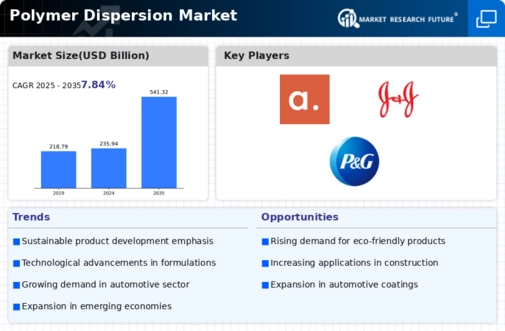Top Industry Leaders in the Polymer Dispersion Market

The polymer dispersion market is a burgeoning space brimming with both competition and opportunity. Delving into this dynamic landscape, we'll explore the strategies driving market share, analyze key industry news, and track the most recent developments.
Market Share Strategies:
Product Diversification: Leading players like BASF, Arkema, and Dow are expanding their portfolios beyond traditional acrylic dispersions, venturing into niche segments like UV-curable and bio-based dispersions to cater to specific end-use demands.
Regional Focus: With Asia Pacific emerging as the fastest-growing market, companies are strategically investing in production capacity and distribution networks in this region. BASF's joint venture with Sinopec in China and Dow's expansion in Thailand are prime examples.
Sustainability Push: Driven by environmental regulations and consumer preferences, sustainability is becoming a key differentiator. Companies are developing eco-friendly dispersions with low VOCs, bio-based content, and improved recyclability. Covestro's EcoVadis Gold rating and Arkema's "Planet Positive" initiative highlight this trend.
Partnerships and Acquisitions: Collaboration is key, with strategic partnerships and acquisitions fostering innovation and market access. Dow's partnership with Kuraray for high-performance dispersions and the acquisition of Evonik's dispersions business by Advent International are recent examples.
Digitalization: Embracing digitalization is critical for optimizing production, enhancing customer service, and driving business intelligence. BASF's SmartCare platform and Arkema's digital marketing initiatives showcase this growing trend.
Factors Influencing Market Share:
Resin Type: Acrylic dispersions currently dominate, but vinyl acetate and polyurethane dispersions are gaining traction due to their unique properties and growing demand in specific applications.
Application Segment: The construction industry remains the largest consumer, followed by paints and coatings, but the adhesives and sealants segment is witnessing rapid growth, fueled by the packaging and automotive industries.
Regional Dynamics: Asia Pacific leads the market, followed by Europe and North America. However, Latin America and Africa are expected to see significant growth in the coming years.
Raw Material Prices: Fluctuations in the prices of monomers like vinyl acetate and acrylic acid can impact production costs and profit margins, influencing market share dynamics.
Environmental Regulations: Stringent regulations on VOC emissions and hazardous materials are driving the development of eco-friendly dispersions, creating opportunities for innovative players.
List of Key Players in the Polymer Dispersion Market
- BASF SE (Germany),
- Arkema (France),
- DIC Corporation (Japan),
- Akzo Nobel NV (Netherlands),
- Asahi Kasei Corporation (Japan),
- Clariant AG (Switzerland),
- Momentive Performance Materials Holdings LLC (US),
- Nuplex Industries Ltd (Australia),
- Omnova Solutions (US),
- Wacker Chemie AG (US),
- Trinseo SA (US),
- the Dow Chemicals Company (US),
- Asian Paints Ltd (India),
- Celanese Corporation (US),
- Cytec Industries Inc. (US),
- Financiera Maderera SA (Spain),
- Eastman Chemical Company (US),
- Lubrizol Corporation (US).
Recent Developments:
September 2023: The World Paint and Coating Industry Association reports a surge in demand for water-based paints and coatings, benefiting polymer dispersion manufacturers.
October 2023: The European Union proposes stricter regulations on volatile organic compounds (VOCs) in paints and coatings. This could impact the demand for certain polymer dispersions used in these applications.
November 2023: BASF launches a digital platform for customers to access technical data and product recommendations for its dispersion portfolio.
December 2023: Dow introduces innovative styrene-butadiene dispersions for improved cold chain packaging These dispersions enhance the performance and sustainability of cold chain packaging solutions.

